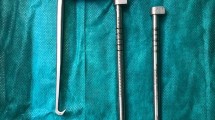Abstract
The present study evaluates the clinical and radiological results of patients with anterior glenoid rim fractures treated with two different open surgical techniques depending on the size of the bony fragment. In patients with displaced glenoid rim fractures involving less than 25% of the glenoid surface (Type I, II and IIIA fractures) suture anchor repair was performed. Patients with a bony defect involving more than 25% of the glenoid surface (Type IIIB fractures) underwent open reduction and internal fixation using cannulated screws. After a mean follow-up of 22 months, 15 patients (mean age 42.2 years) treated with suture anchor repair achieved an average Constant Score of 85.5 points (range 67.1–100) and an average Rowe Score of 94 points (range 70–100). In six patients the bony fragment was located in an unimproved medial position compared to the preoperative X-ray. In another six patients the fragment was consolidated medially to the level of the glenoid rim, and in three cases an anatomic situation was found. Patients treated with cannulated screws (ten cases, mean age 46.6 years) had a mean follow-up of 30 months and achieved a mean Constant Score of 81.9 points (range 61.7–96.1) and a mean Rowe Score of 90 points (range 70–100). Radiologically, the bony fragment was consolidated in an anatomic position in nine out of ten cases. Three patients suffered from screw impingement and one patient had screw loosening. No recurrent subluxations or dislocations were observed in either group. Three patients in group one and one patient in group two had glenohumeral osteoarthritic changes. In cases of small glenoid-rim fractures (Type I, II and IIIA fractures), suture anchor repair resulted in an excellent clinical outcome; however, the radiological results of chronic Type I fractures revealed in many cases a non-anatomical glenoidal reconstruction. For Type IIIB fractures with significant loss of glenoid concavity, open reduction and internal fixation with cannulated screws gave good clinical and radiological results; however the early complication rate was higher.





Similar content being viewed by others
References
Aston JW, Gregory CF (1973) Dislocation of the shoulder with significant fracture of the glenoid. J Bone Joint Surg Am 55:1531–1533
Bigliani LU, Newton PM, Steinmann SP, Connor PM, McIlveen SJ (1998) Glenoid rim lesions associated with recurrent anterior dislocation of the shoulder. Am J Sports Med 26:41–45
Burkhart SS, De Beer JF (2000) Traumatic glenohumeral bone defects and their relationship to failure of arthroscopic Bankart repairs: significance of the inverted-pear glenoid and the humeral engaging Hill–Sachs lesion. Arthroscopy 16:677–694
Cameron SE (1998) Arthroscopic reduction and internal fixation of an anterior glenoid fracture. Case report. Arthroscopy 14:743–746
Constant CR, Murley AHG (1987) A clinical method of functional assessment of the shoulder. Clin Orthop 214:160–164
De Palma AF (1983) Fractures and fracture-dislocations of the shoulder girdle. In: Jacob RP, Kristiansen T, Mayo K, Ganz R, Mueller ME (eds) Surgery of the shoulder, 3rd edn. Lippincott, Philadelphia, pp 366–367
Gerber G, Schneeberger AG, Beck M, Schlegel U (1994) Mechanical strength of repairs of the rotator cuff. J Bone Joint Surg Br 76:371–380
Gohlke F, Fix C, Baumann B, Böhm D (2003) Clinical results after surgical repair of glenoid rim fractures using cannulated titanium screws. Book of abstracts of the 17th Congress of the European Society for Surgery of the Shoulder and the Elbow, Heidelberg, Germany, p 263
Helfet AJ (1958) Coracoid transplantation for recurring dislocation of the shoulder. J Bone Joint Surg Br 40:198–202
Itoi E, Lee SB, Berglund LJ, Berge LL, An KN (2000) The effect of a glenoid defect on anteroinferior stability of the shoulder after Bankart repair: a cadaveric study. J Bone Joint Surg Am 82:35–46
Kummel BM (1970) Fractures of the glenoid causing chronic dislocation of the shoulder. Clin Orthop 69:189–191
Latarjet M (1965) Techniques chirurgicales dans le traitemant de la luxation anteriointerne recidivante de l’epaule. Lyon Chir 61:313–318
Malicky DM, Soslowsky LJ, Blasier RB, Shyr Y (1996) Anterior glenohumeral stabilization factors: progressive effects in a biomechanical model. J Orthop Res 14:282–288
Matsen FA III, Lippitt SB, Sidles JA, Harryman DT II (1994) Practical evaluation and management of the shoulder. Saunders, Philadelphia
Palmer I, Widén A (1948) The bone block method for recurrent dislocation of the shoulder joint. J Bone Joint Surg Br 30:3
Porcellini G, Fabrizio C, Paladini P (2002) Arthroscopic approach to bony Bankart lesion. Arthroscopy 18:764–769
Rockwood CA, Matsen FA (1990) The scapula. In: Butters KP (ed) The shoulder. Saunders, Philadelphia
Rowe CR, Sakellarides HT (1961) Factors related to recurrences of anterior dislocations of the shoulder. Clin Orthop 20:40–48
Rowe CR, Patel D, Southmayd WW (1978) The Bankart procedure. A long-term end-result study. J Bone Joint Surg Am 60:1–16
Samilson RL, Prieto V (1983) Dislocation arthropathy of the shoulder. J Bone Joint Surg Am 65:456–460
Scheibel MT, Habermeyer P (2003) A modified Mason-Allen technique using suture anchors. Arthroscopy 19:330–333
Wiedemann E (2002) Scapulafraktur. In: Habermeyer P (ed) Schulterchirurgie, 3rd edn. Urban & Fischer, pp 453–468
Author information
Authors and Affiliations
Corresponding author
Rights and permissions
About this article
Cite this article
Scheibel, M., Magosch, P., Lichtenberg, S. et al. Open reconstruction of anterior glenoid rim fractures. Knee Surg Sports Traumatol Arthrosc 12, 568–573 (2004). https://doi.org/10.1007/s00167-004-0495-7
Received:
Accepted:
Published:
Issue Date:
DOI: https://doi.org/10.1007/s00167-004-0495-7




